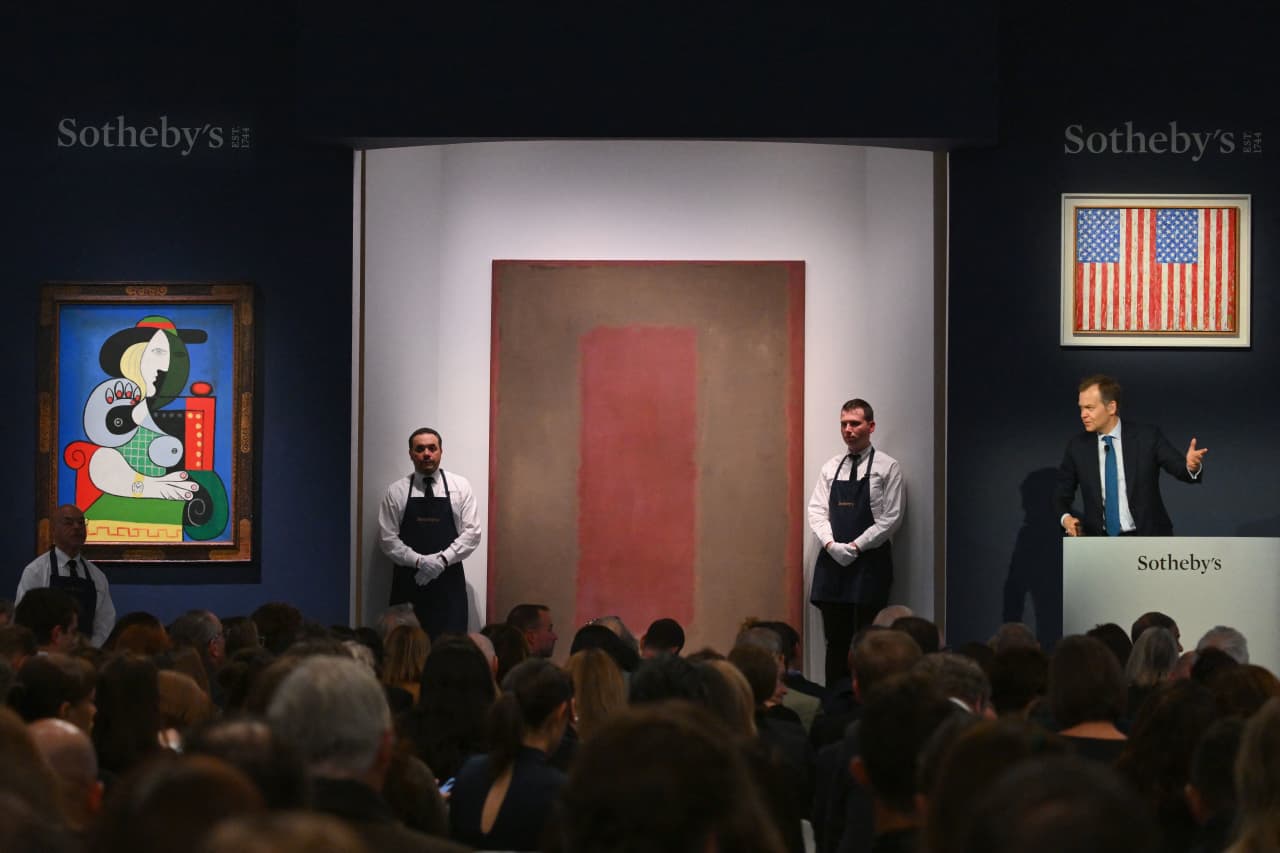Picasso, Monet, Warhol, Basquiat, and Richter Lead Artists Powering the US$1 Million-Plus Market
Pablo Picasso, Claude Monet, Andy Warhol, Jean-Michel Basquiat, and Gerhard Richter top a list of 50 artists leading the momentum for works valued at US$1 million or more, according to a report released Tuesday by Sotheby’s and ArtTactic, a London art market analysis firm.
The list ranked artists with an average of five artworks of US$1 million or more that sold each year between 2018 and 2022 at Christie’s, Phillips, and Sotheby’s—a methodology aimed at showing consistency. The analysis also considers sales value, liquidity, average prices, bidder confidence, and market momentum for each artist, and draws on Sotheby’s internal data on bidders and private sales.
Works by the top five artists alone made up more than a third of all US$1 million-plus sales at these top global auction houses in those years, the report said.
Shifts may be afoot, however. A “Power Rank” of top artists in the US$1 million-plus category, based on data from July 2022 to June 2023, “aims to identify artists whose markets show signs of growing momentum and interest,” the report said.
The top artists of this 12-month Power Rank are Jasper Johns, Lucian Freud, Paul Gaugin, Wassily Kandinksy, and Willem de Kooning.
“The Artists Who Power the $1 Million+ Market” is the second report by Sotheby’s and ArtTactic to explore this segment of the auction world, which proved to be “especially resilient” in 2021 and 2022, during the height of the pandemic and the beginning of the war in Ukraine. Despite representing a “small fraction” of works sold at auction, art that fetches at least US$1 million has “a tremendous impact on the market at lower levels,” the report said.
The analysis considers auction results at Christie’s, Phillips, and Sotheby’s in four categories: contemporary (including Post-War), impressionist and modern, Old Masters, and Chinese works of art. The list of top 50 artists from 2018 to 2022 who are powering the US$1 million-plus sector also includes insights from Sotheby’s private sales and its bidding activity data. Though the latter information is from Sotheby’s alone, similar activity is likely taking place at other auction houses, the report said.
“We all know that the art market has never been as transparent as the financial markets, so any information we can give our clients in terms of trends, analysis, and insight will allow them to make more thoughtful and educated decisions about their purchases, whether they see them as an investment or are pursuing a passion,” Mari-Claudia Jiménez, Sotheby’s head of global business development, said during a roundtable discussion with her colleagues and ArtTactic CEO Anders Petterson that’s included in the report.
The rare insight into private-sale data revealed that works by Alberto Giacometti, in addition to Monet, Basquiat, Picasso and Warhol, made up nearly 80% of Sotheby’s private transactions in the first half of this year. From 2019 to the first half of 2023, these same artists represented only 44.7% of private sales.
Sotheby’s internal bidding data—also rare to see—shows a rise in bidding for works with estimates between US$20 million and US$50 million in the first half of this year. “Despite market uncertainty,” this lofty segment has attracted 6.1% of bidders in the market for works valued at US$1 million or more, up from 3.8% in 2022, the report said.
Nearly 75% of Sotheby’s bidders raised their paddles for works priced between US$1 million and US$5 million from 2018 to 2022, though the percentage slipped to 72.4% in the first half of the year as 13.8% of collectors bid on works valued between US$5 million and US$10 million (up from 12.5% in 2022).
ArtTactic dug deeper into this internal bidding data to understand what category of works these collectors favoured, where they live, and how old they are. The data “provides collectors with additional context to understand some of the drivers behind emerging trends,” the report said.
Among its findings: Contemporary art was favoured by 56.1% of bidders; North Americans bid the most, representing nearly 36.4% of those vying for works of US$1 million or more; and Generation X is making their mark, accounting for the largest share of bidders in the market at 40.2%.
This generational shift is significant. Younger collectors are more comfortable buying across art categories, from Old Masters to Contemporary, for instance.
“The data in the report shows that our collectors, even the youngest ones, are interested in the entire span of history,” Brooke Lampley, Sotheby’s head of global fine art, said during the roundtable. “Education is such an important factor in the art market, and people are learning about art history in many different ways today.”
These younger collectors are interested in art in part because they are more exposed to it than previous generations, Lampley said. Private collectors today are exposed through the numerous art fairs they attend in addition to public auctions, which generations ago were attended more by dealers and others in the trade who then sold the works, she said.
“There has been a great effort to make people feel included in the art world and to make it accessible, both by galleries and auction houses,” Lampley said.
Notably, there are no women artists among the top five of the list of 50 powering the US$1 million-plus market, although four made the larger list. Joan Mitchell ranks No. 17, Yayoi Kusama ranks No. 19, Cecily Brown ranks No. 39, and Helen Frankenthaler ranks No. 47.
 Copyright 2020, Dow Jones & Company, Inc. All Rights Reserved Worldwide. LEARN MORE
Copyright 2020, Dow Jones & Company, Inc. All Rights Reserved Worldwide. LEARN MORE
This stylish family home combines a classic palette and finishes with a flexible floorplan
Just 55 minutes from Sydney, make this your creative getaway located in the majestic Hawkesbury region.
Continued stagflation and cost of living pressures are causing couples to think twice about starting a family, new data has revealed, with long term impacts expected
Australia is in the midst of a ‘baby recession’ with preliminary estimates showing the number of births in 2023 fell by more than four percent to the lowest level since 2006, according to KPMG. The consultancy firm says this reflects the impact of cost-of-living pressures on the feasibility of younger Australians starting a family.
KPMG estimates that 289,100 babies were born in 2023. This compares to 300,684 babies in 2022 and 309,996 in 2021, according to the Australian Bureau of Statistics (ABS). KPMG urban economist Terry Rawnsley said weak economic growth often leads to a reduced number of births. In 2023, ABS data shows gross domestic product (GDP) fell to 1.5 percent. Despite the population growing by 2.5 percent in 2023, GDP on a per capita basis went into negative territory, down one percent over the 12 months.
“Birth rates provide insight into long-term population growth as well as the current confidence of Australian families,” said Mr Rawnsley. “We haven’t seen such a sharp drop in births in Australia since the period of economic stagflation in the 1970s, which coincided with the initial widespread adoption of the contraceptive pill.”
Mr Rawnsley said many Australian couples delayed starting a family while the pandemic played out in 2020. The number of births fell from 305,832 in 2019 to 294,369 in 2020. Then in 2021, strong employment and vast amounts of stimulus money, along with high household savings due to lockdowns, gave couples better financial means to have a baby. This led to a rebound in births.
However, the re-opening of the global economy in 2022 led to soaring inflation. By the start of 2023, the Australian consumer price index (CPI) had risen to its highest level since 1990 at 7.8 percent per annum. By that stage, the Reserve Bank had already commenced an aggressive rate-hiking strategy to fight inflation and had raised the cash rate every month between May and December 2022.
Five more rate hikes during 2023 put further pressure on couples with mortgages and put the brakes on family formation. “This combination of the pandemic and rapid economic changes explains the spike and subsequent sharp decline in birth rates we have observed over the past four years,” Mr Rawnsley said.
The impact of high costs of living on couples’ decision to have a baby is highlighted in births data for the capital cities. KPMG estimates there were 60,860 births in Sydney in 2023, down 8.6 percent from 2019. There were 56,270 births in Melbourne, down 7.3 percent. In Perth, there were 25,020 births, down 6 percent, while in Brisbane there were 30,250 births, down 4.3 percent. Canberra was the only capital city where there was no fall in the number of births in 2023 compared to 2019.
“CPI growth in Canberra has been slightly subdued compared to that in other major cities, and the economic outlook has remained strong,” Mr Rawnsley said. “This means families have not been hurting as much as those in other capital cities, and in turn, we’ve seen a stabilisation of births in the ACT.”
This stylish family home combines a classic palette and finishes with a flexible floorplan
Just 55 minutes from Sydney, make this your creative getaway located in the majestic Hawkesbury region.






















